Impact of IT on Business: POS Systems and Centralised Database
VerifiedAdded on 2020/10/23
|12
|3024
|306
AI Summary
This report examines the impact of Information Technology (IT) on business, with a focus on the implementation of Point of Sale (POS) systems and the importance of Centralised Databases. The study highlights several advantages and disadvantages of POS systems, including their ability to render decision-making and create types of risks. It also discusses methods to protect these uncertainties.
Contribute Materials
Your contribution can guide someone’s learning journey. Share your
documents today.

IMPACT OF IT ON
BUSINESS
BUSINESS
Secure Best Marks with AI Grader
Need help grading? Try our AI Grader for instant feedback on your assignments.
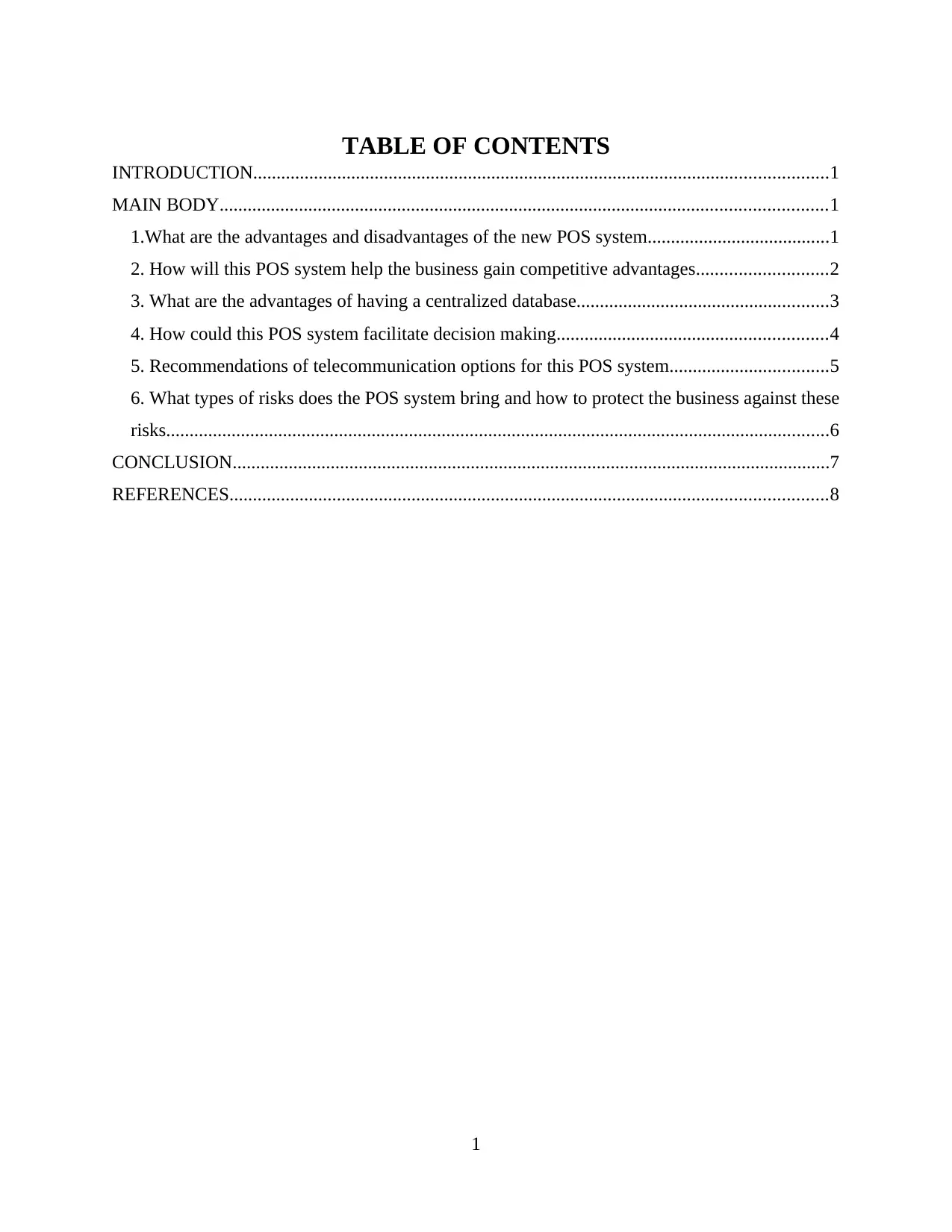
TABLE OF CONTENTS
INTRODUCTION...........................................................................................................................1
MAIN BODY..................................................................................................................................1
1.What are the advantages and disadvantages of the new POS system.......................................1
2. How will this POS system help the business gain competitive advantages............................2
3. What are the advantages of having a centralized database......................................................3
4. How could this POS system facilitate decision making..........................................................4
5. Recommendations of telecommunication options for this POS system..................................5
6. What types of risks does the POS system bring and how to protect the business against these
risks..............................................................................................................................................6
CONCLUSION................................................................................................................................7
REFERENCES................................................................................................................................8
1
INTRODUCTION...........................................................................................................................1
MAIN BODY..................................................................................................................................1
1.What are the advantages and disadvantages of the new POS system.......................................1
2. How will this POS system help the business gain competitive advantages............................2
3. What are the advantages of having a centralized database......................................................3
4. How could this POS system facilitate decision making..........................................................4
5. Recommendations of telecommunication options for this POS system..................................5
6. What types of risks does the POS system bring and how to protect the business against these
risks..............................................................................................................................................6
CONCLUSION................................................................................................................................7
REFERENCES................................................................................................................................8
1
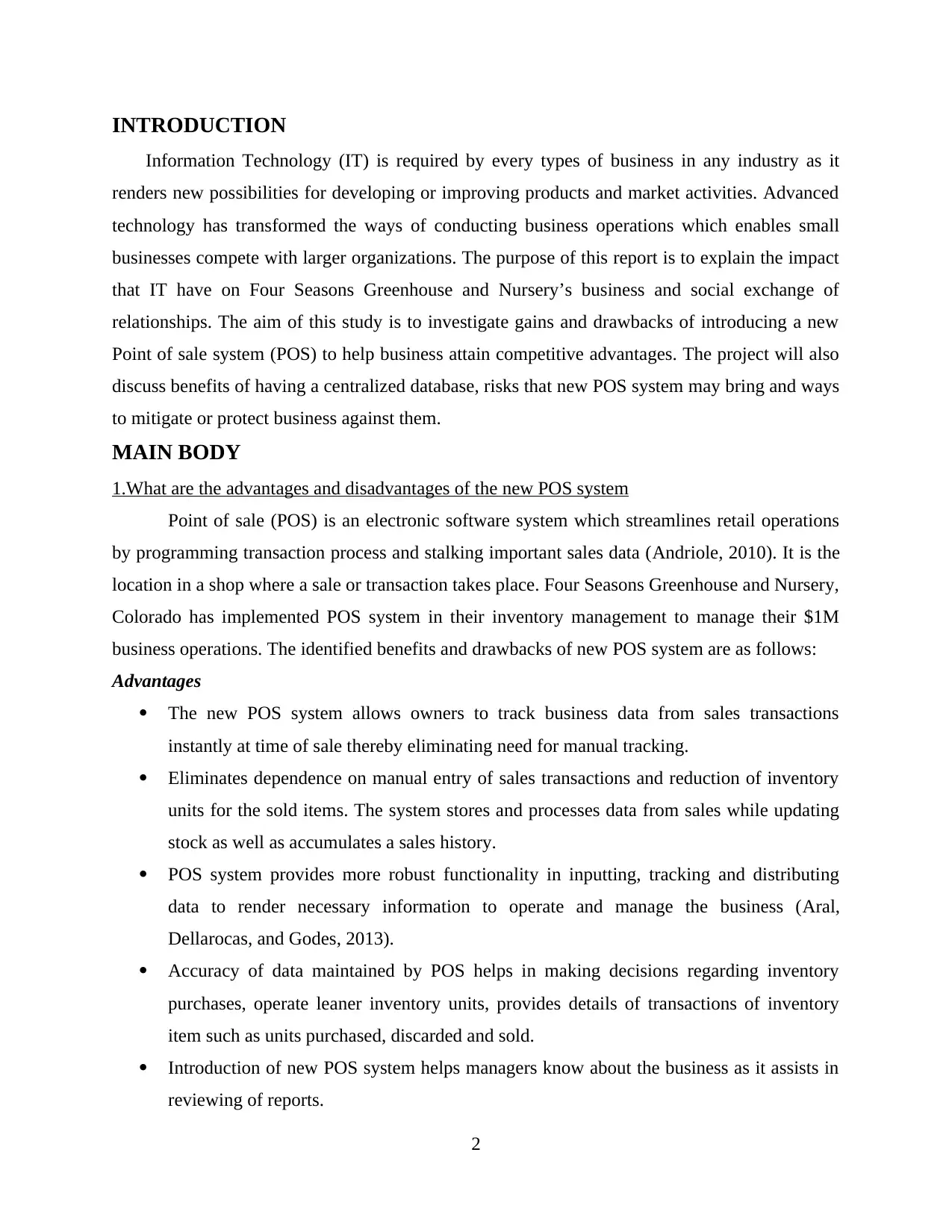
INTRODUCTION
Information Technology (IT) is required by every types of business in any industry as it
renders new possibilities for developing or improving products and market activities. Advanced
technology has transformed the ways of conducting business operations which enables small
businesses compete with larger organizations. The purpose of this report is to explain the impact
that IT have on Four Seasons Greenhouse and Nursery’s business and social exchange of
relationships. The aim of this study is to investigate gains and drawbacks of introducing a new
Point of sale system (POS) to help business attain competitive advantages. The project will also
discuss benefits of having a centralized database, risks that new POS system may bring and ways
to mitigate or protect business against them.
MAIN BODY
1.What are the advantages and disadvantages of the new POS system
Point of sale (POS) is an electronic software system which streamlines retail operations
by programming transaction process and stalking important sales data (Andriole, 2010). It is the
location in a shop where a sale or transaction takes place. Four Seasons Greenhouse and Nursery,
Colorado has implemented POS system in their inventory management to manage their $1M
business operations. The identified benefits and drawbacks of new POS system are as follows:
Advantages
The new POS system allows owners to track business data from sales transactions
instantly at time of sale thereby eliminating need for manual tracking.
Eliminates dependence on manual entry of sales transactions and reduction of inventory
units for the sold items. The system stores and processes data from sales while updating
stock as well as accumulates a sales history.
POS system provides more robust functionality in inputting, tracking and distributing
data to render necessary information to operate and manage the business (Aral,
Dellarocas, and Godes, 2013).
Accuracy of data maintained by POS helps in making decisions regarding inventory
purchases, operate leaner inventory units, provides details of transactions of inventory
item such as units purchased, discarded and sold.
Introduction of new POS system helps managers know about the business as it assists in
reviewing of reports.
2
Information Technology (IT) is required by every types of business in any industry as it
renders new possibilities for developing or improving products and market activities. Advanced
technology has transformed the ways of conducting business operations which enables small
businesses compete with larger organizations. The purpose of this report is to explain the impact
that IT have on Four Seasons Greenhouse and Nursery’s business and social exchange of
relationships. The aim of this study is to investigate gains and drawbacks of introducing a new
Point of sale system (POS) to help business attain competitive advantages. The project will also
discuss benefits of having a centralized database, risks that new POS system may bring and ways
to mitigate or protect business against them.
MAIN BODY
1.What are the advantages and disadvantages of the new POS system
Point of sale (POS) is an electronic software system which streamlines retail operations
by programming transaction process and stalking important sales data (Andriole, 2010). It is the
location in a shop where a sale or transaction takes place. Four Seasons Greenhouse and Nursery,
Colorado has implemented POS system in their inventory management to manage their $1M
business operations. The identified benefits and drawbacks of new POS system are as follows:
Advantages
The new POS system allows owners to track business data from sales transactions
instantly at time of sale thereby eliminating need for manual tracking.
Eliminates dependence on manual entry of sales transactions and reduction of inventory
units for the sold items. The system stores and processes data from sales while updating
stock as well as accumulates a sales history.
POS system provides more robust functionality in inputting, tracking and distributing
data to render necessary information to operate and manage the business (Aral,
Dellarocas, and Godes, 2013).
Accuracy of data maintained by POS helps in making decisions regarding inventory
purchases, operate leaner inventory units, provides details of transactions of inventory
item such as units purchased, discarded and sold.
Introduction of new POS system helps managers know about the business as it assists in
reviewing of reports.
2
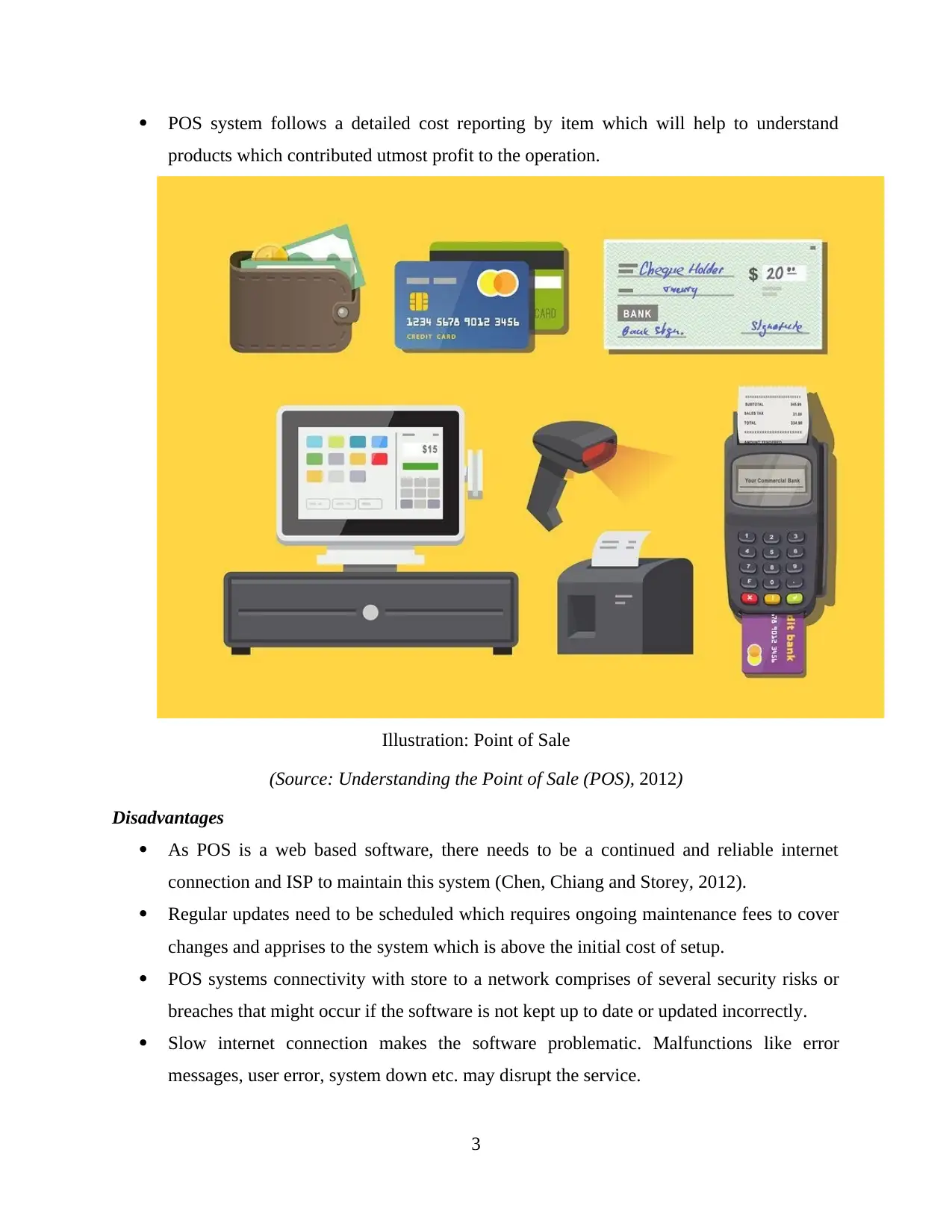
POS system follows a detailed cost reporting by item which will help to understand
products which contributed utmost profit to the operation.
Illustration: Point of Sale
(Source: Understanding the Point of Sale (POS), 2012)
Disadvantages
As POS is a web based software, there needs to be a continued and reliable internet
connection and ISP to maintain this system (Chen, Chiang and Storey, 2012).
Regular updates need to be scheduled which requires ongoing maintenance fees to cover
changes and apprises to the system which is above the initial cost of setup.
POS systems connectivity with store to a network comprises of several security risks or
breaches that might occur if the software is not kept up to date or updated incorrectly.
Slow internet connection makes the software problematic. Malfunctions like error
messages, user error, system down etc. may disrupt the service.
3
products which contributed utmost profit to the operation.
Illustration: Point of Sale
(Source: Understanding the Point of Sale (POS), 2012)
Disadvantages
As POS is a web based software, there needs to be a continued and reliable internet
connection and ISP to maintain this system (Chen, Chiang and Storey, 2012).
Regular updates need to be scheduled which requires ongoing maintenance fees to cover
changes and apprises to the system which is above the initial cost of setup.
POS systems connectivity with store to a network comprises of several security risks or
breaches that might occur if the software is not kept up to date or updated incorrectly.
Slow internet connection makes the software problematic. Malfunctions like error
messages, user error, system down etc. may disrupt the service.
3
Secure Best Marks with AI Grader
Need help grading? Try our AI Grader for instant feedback on your assignments.
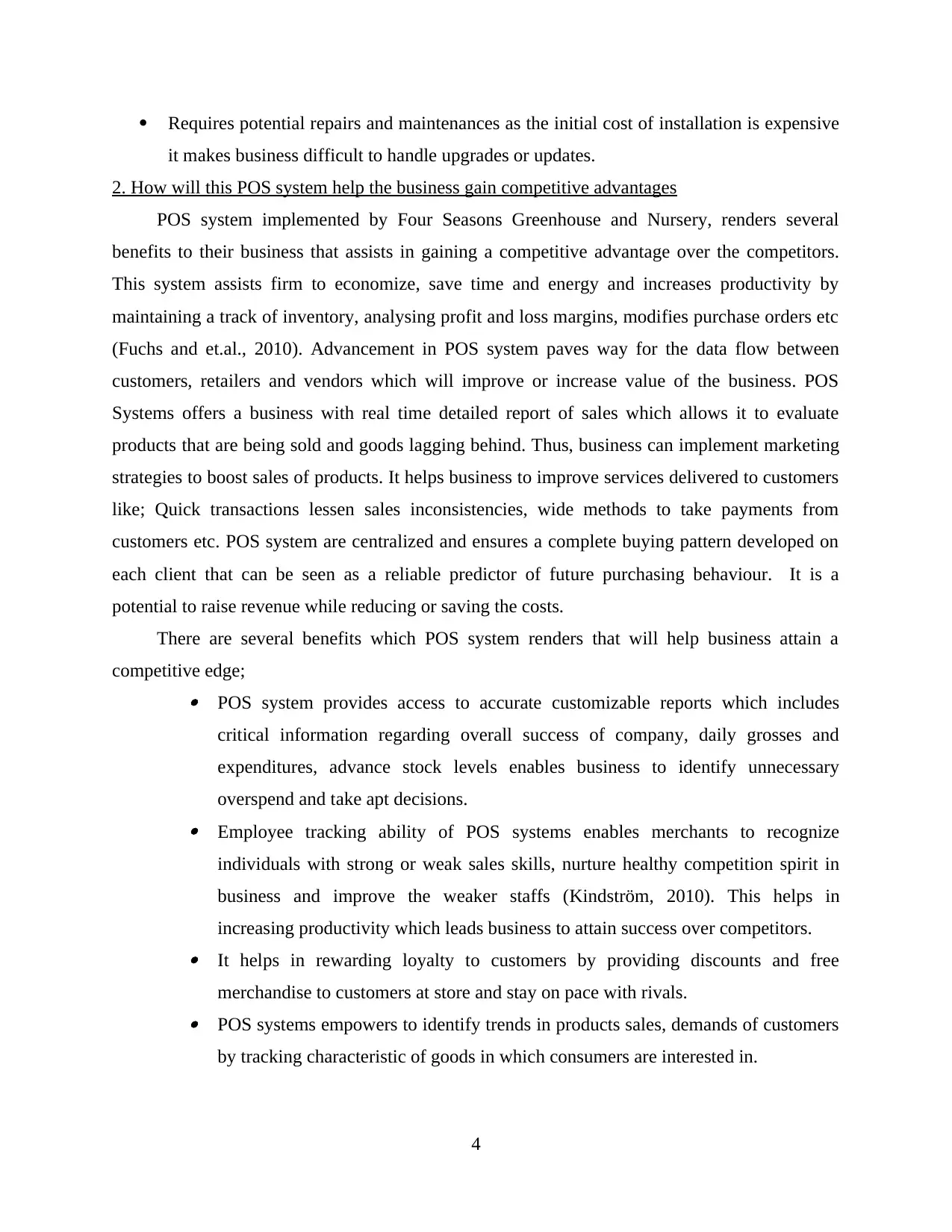
Requires potential repairs and maintenances as the initial cost of installation is expensive
it makes business difficult to handle upgrades or updates.
2. How will this POS system help the business gain competitive advantages
POS system implemented by Four Seasons Greenhouse and Nursery, renders several
benefits to their business that assists in gaining a competitive advantage over the competitors.
This system assists firm to economize, save time and energy and increases productivity by
maintaining a track of inventory, analysing profit and loss margins, modifies purchase orders etc
(Fuchs and et.al., 2010). Advancement in POS system paves way for the data flow between
customers, retailers and vendors which will improve or increase value of the business. POS
Systems offers a business with real time detailed report of sales which allows it to evaluate
products that are being sold and goods lagging behind. Thus, business can implement marketing
strategies to boost sales of products. It helps business to improve services delivered to customers
like; Quick transactions lessen sales inconsistencies, wide methods to take payments from
customers etc. POS system are centralized and ensures a complete buying pattern developed on
each client that can be seen as a reliable predictor of future purchasing behaviour. It is a
potential to raise revenue while reducing or saving the costs.
There are several benefits which POS system renders that will help business attain a
competitive edge;
POS system provides access to accurate customizable reports which includes
critical information regarding overall success of company, daily grosses and
expenditures, advance stock levels enables business to identify unnecessary
overspend and take apt decisions.
Employee tracking ability of POS systems enables merchants to recognize
individuals with strong or weak sales skills, nurture healthy competition spirit in
business and improve the weaker staffs (Kindström, 2010). This helps in
increasing productivity which leads business to attain success over competitors.
It helps in rewarding loyalty to customers by providing discounts and free
merchandise to customers at store and stay on pace with rivals.
POS systems empowers to identify trends in products sales, demands of customers
by tracking characteristic of goods in which consumers are interested in.
4
it makes business difficult to handle upgrades or updates.
2. How will this POS system help the business gain competitive advantages
POS system implemented by Four Seasons Greenhouse and Nursery, renders several
benefits to their business that assists in gaining a competitive advantage over the competitors.
This system assists firm to economize, save time and energy and increases productivity by
maintaining a track of inventory, analysing profit and loss margins, modifies purchase orders etc
(Fuchs and et.al., 2010). Advancement in POS system paves way for the data flow between
customers, retailers and vendors which will improve or increase value of the business. POS
Systems offers a business with real time detailed report of sales which allows it to evaluate
products that are being sold and goods lagging behind. Thus, business can implement marketing
strategies to boost sales of products. It helps business to improve services delivered to customers
like; Quick transactions lessen sales inconsistencies, wide methods to take payments from
customers etc. POS system are centralized and ensures a complete buying pattern developed on
each client that can be seen as a reliable predictor of future purchasing behaviour. It is a
potential to raise revenue while reducing or saving the costs.
There are several benefits which POS system renders that will help business attain a
competitive edge;
POS system provides access to accurate customizable reports which includes
critical information regarding overall success of company, daily grosses and
expenditures, advance stock levels enables business to identify unnecessary
overspend and take apt decisions.
Employee tracking ability of POS systems enables merchants to recognize
individuals with strong or weak sales skills, nurture healthy competition spirit in
business and improve the weaker staffs (Kindström, 2010). This helps in
increasing productivity which leads business to attain success over competitors.
It helps in rewarding loyalty to customers by providing discounts and free
merchandise to customers at store and stay on pace with rivals.
POS systems empowers to identify trends in products sales, demands of customers
by tracking characteristic of goods in which consumers are interested in.
4
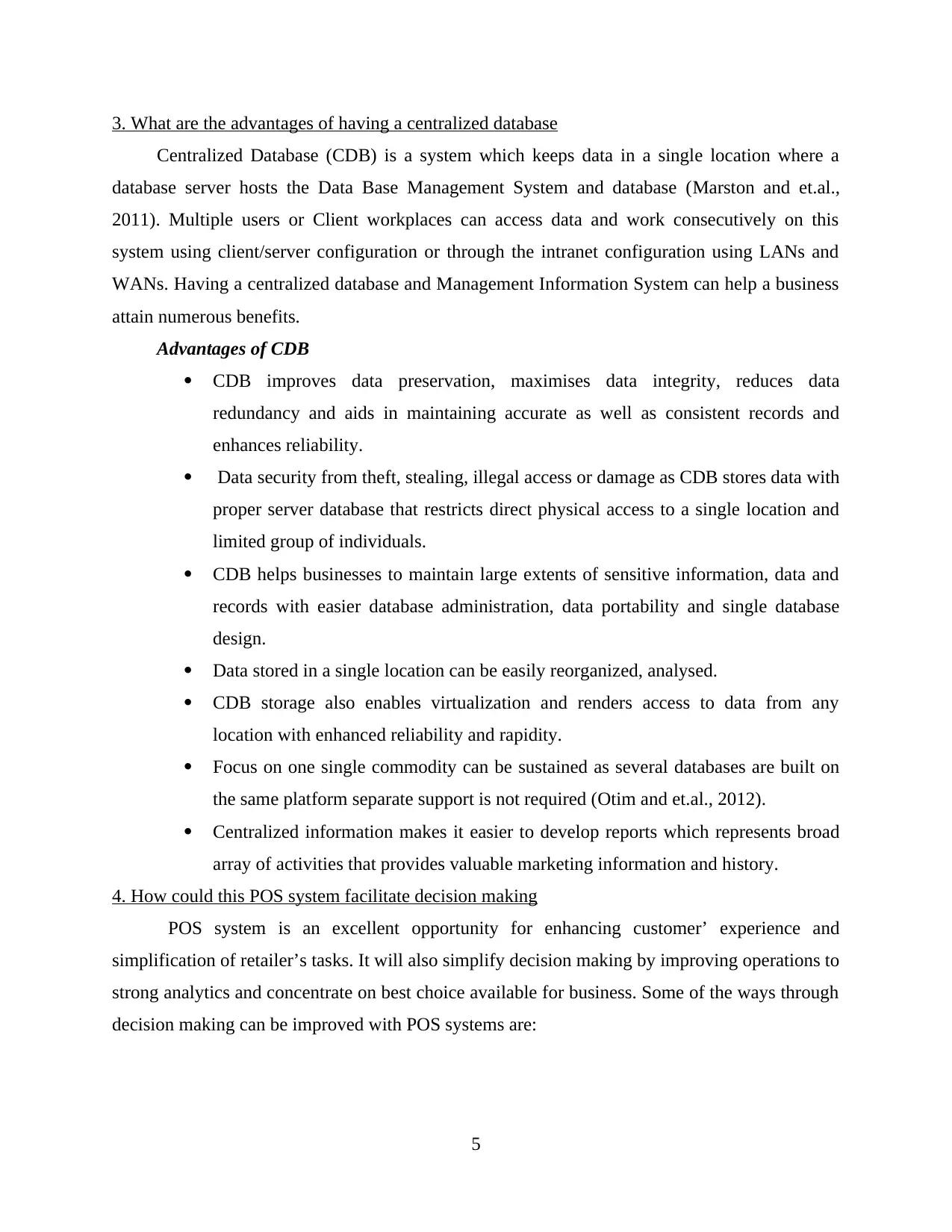
3. What are the advantages of having a centralized database
Centralized Database (CDB) is a system which keeps data in a single location where a
database server hosts the Data Base Management System and database (Marston and et.al.,
2011). Multiple users or Client workplaces can access data and work consecutively on this
system using client/server configuration or through the intranet configuration using LANs and
WANs. Having a centralized database and Management Information System can help a business
attain numerous benefits.
Advantages of CDB
CDB improves data preservation, maximises data integrity, reduces data
redundancy and aids in maintaining accurate as well as consistent records and
enhances reliability.
Data security from theft, stealing, illegal access or damage as CDB stores data with
proper server database that restricts direct physical access to a single location and
limited group of individuals.
CDB helps businesses to maintain large extents of sensitive information, data and
records with easier database administration, data portability and single database
design.
Data stored in a single location can be easily reorganized, analysed.
CDB storage also enables virtualization and renders access to data from any
location with enhanced reliability and rapidity.
Focus on one single commodity can be sustained as several databases are built on
the same platform separate support is not required (Otim and et.al., 2012).
Centralized information makes it easier to develop reports which represents broad
array of activities that provides valuable marketing information and history.
4. How could this POS system facilitate decision making
POS system is an excellent opportunity for enhancing customer’ experience and
simplification of retailer’s tasks. It will also simplify decision making by improving operations to
strong analytics and concentrate on best choice available for business. Some of the ways through
decision making can be improved with POS systems are:
5
Centralized Database (CDB) is a system which keeps data in a single location where a
database server hosts the Data Base Management System and database (Marston and et.al.,
2011). Multiple users or Client workplaces can access data and work consecutively on this
system using client/server configuration or through the intranet configuration using LANs and
WANs. Having a centralized database and Management Information System can help a business
attain numerous benefits.
Advantages of CDB
CDB improves data preservation, maximises data integrity, reduces data
redundancy and aids in maintaining accurate as well as consistent records and
enhances reliability.
Data security from theft, stealing, illegal access or damage as CDB stores data with
proper server database that restricts direct physical access to a single location and
limited group of individuals.
CDB helps businesses to maintain large extents of sensitive information, data and
records with easier database administration, data portability and single database
design.
Data stored in a single location can be easily reorganized, analysed.
CDB storage also enables virtualization and renders access to data from any
location with enhanced reliability and rapidity.
Focus on one single commodity can be sustained as several databases are built on
the same platform separate support is not required (Otim and et.al., 2012).
Centralized information makes it easier to develop reports which represents broad
array of activities that provides valuable marketing information and history.
4. How could this POS system facilitate decision making
POS system is an excellent opportunity for enhancing customer’ experience and
simplification of retailer’s tasks. It will also simplify decision making by improving operations to
strong analytics and concentrate on best choice available for business. Some of the ways through
decision making can be improved with POS systems are:
5
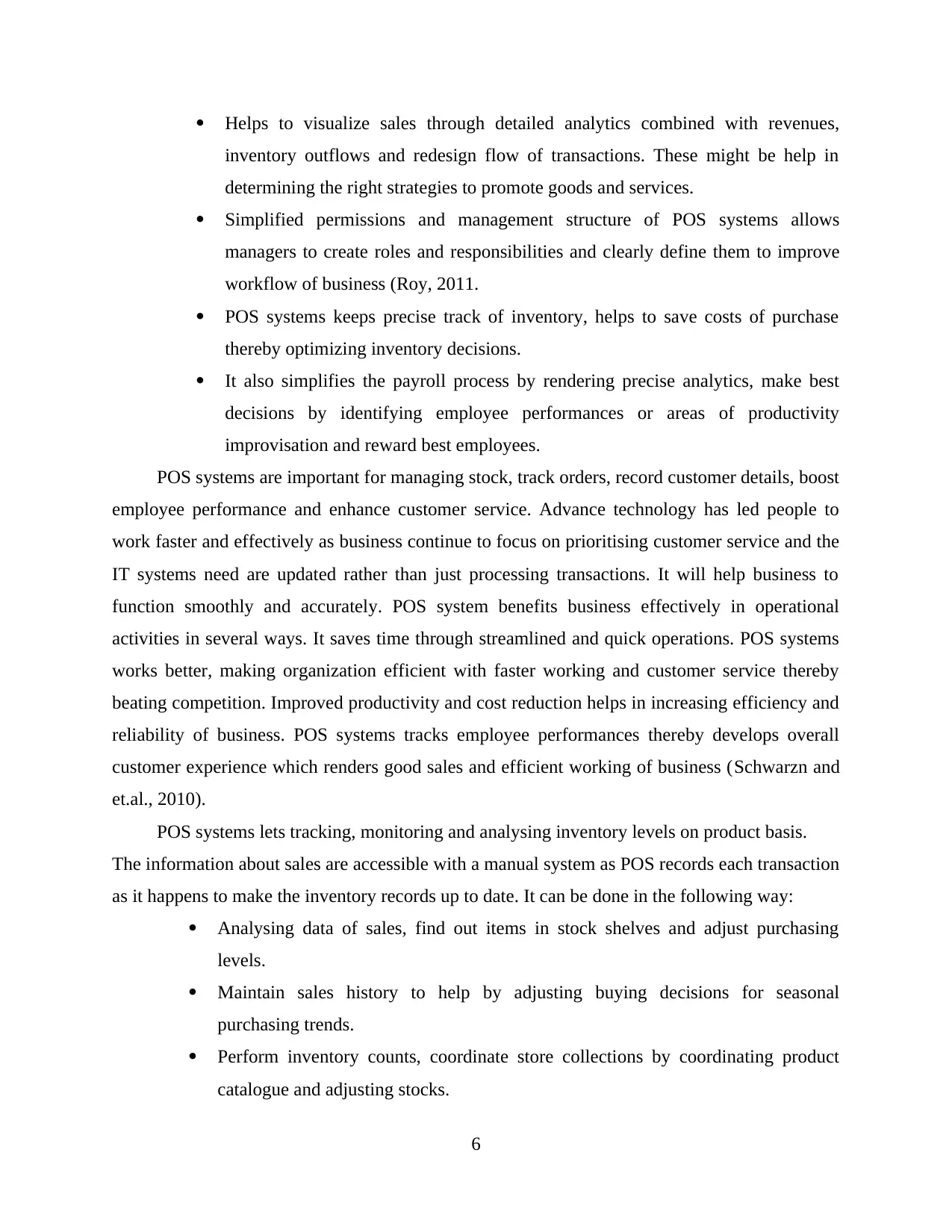
Helps to visualize sales through detailed analytics combined with revenues,
inventory outflows and redesign flow of transactions. These might be help in
determining the right strategies to promote goods and services.
Simplified permissions and management structure of POS systems allows
managers to create roles and responsibilities and clearly define them to improve
workflow of business (Roy, 2011.
POS systems keeps precise track of inventory, helps to save costs of purchase
thereby optimizing inventory decisions.
It also simplifies the payroll process by rendering precise analytics, make best
decisions by identifying employee performances or areas of productivity
improvisation and reward best employees.
POS systems are important for managing stock, track orders, record customer details, boost
employee performance and enhance customer service. Advance technology has led people to
work faster and effectively as business continue to focus on prioritising customer service and the
IT systems need are updated rather than just processing transactions. It will help business to
function smoothly and accurately. POS system benefits business effectively in operational
activities in several ways. It saves time through streamlined and quick operations. POS systems
works better, making organization efficient with faster working and customer service thereby
beating competition. Improved productivity and cost reduction helps in increasing efficiency and
reliability of business. POS systems tracks employee performances thereby develops overall
customer experience which renders good sales and efficient working of business (Schwarzn and
et.al., 2010).
POS systems lets tracking, monitoring and analysing inventory levels on product basis.
The information about sales are accessible with a manual system as POS records each transaction
as it happens to make the inventory records up to date. It can be done in the following way:
Analysing data of sales, find out items in stock shelves and adjust purchasing
levels.
Maintain sales history to help by adjusting buying decisions for seasonal
purchasing trends.
Perform inventory counts, coordinate store collections by coordinating product
catalogue and adjusting stocks.
6
inventory outflows and redesign flow of transactions. These might be help in
determining the right strategies to promote goods and services.
Simplified permissions and management structure of POS systems allows
managers to create roles and responsibilities and clearly define them to improve
workflow of business (Roy, 2011.
POS systems keeps precise track of inventory, helps to save costs of purchase
thereby optimizing inventory decisions.
It also simplifies the payroll process by rendering precise analytics, make best
decisions by identifying employee performances or areas of productivity
improvisation and reward best employees.
POS systems are important for managing stock, track orders, record customer details, boost
employee performance and enhance customer service. Advance technology has led people to
work faster and effectively as business continue to focus on prioritising customer service and the
IT systems need are updated rather than just processing transactions. It will help business to
function smoothly and accurately. POS system benefits business effectively in operational
activities in several ways. It saves time through streamlined and quick operations. POS systems
works better, making organization efficient with faster working and customer service thereby
beating competition. Improved productivity and cost reduction helps in increasing efficiency and
reliability of business. POS systems tracks employee performances thereby develops overall
customer experience which renders good sales and efficient working of business (Schwarzn and
et.al., 2010).
POS systems lets tracking, monitoring and analysing inventory levels on product basis.
The information about sales are accessible with a manual system as POS records each transaction
as it happens to make the inventory records up to date. It can be done in the following way:
Analysing data of sales, find out items in stock shelves and adjust purchasing
levels.
Maintain sales history to help by adjusting buying decisions for seasonal
purchasing trends.
Perform inventory counts, coordinate store collections by coordinating product
catalogue and adjusting stocks.
6
Paraphrase This Document
Need a fresh take? Get an instant paraphrase of this document with our AI Paraphraser
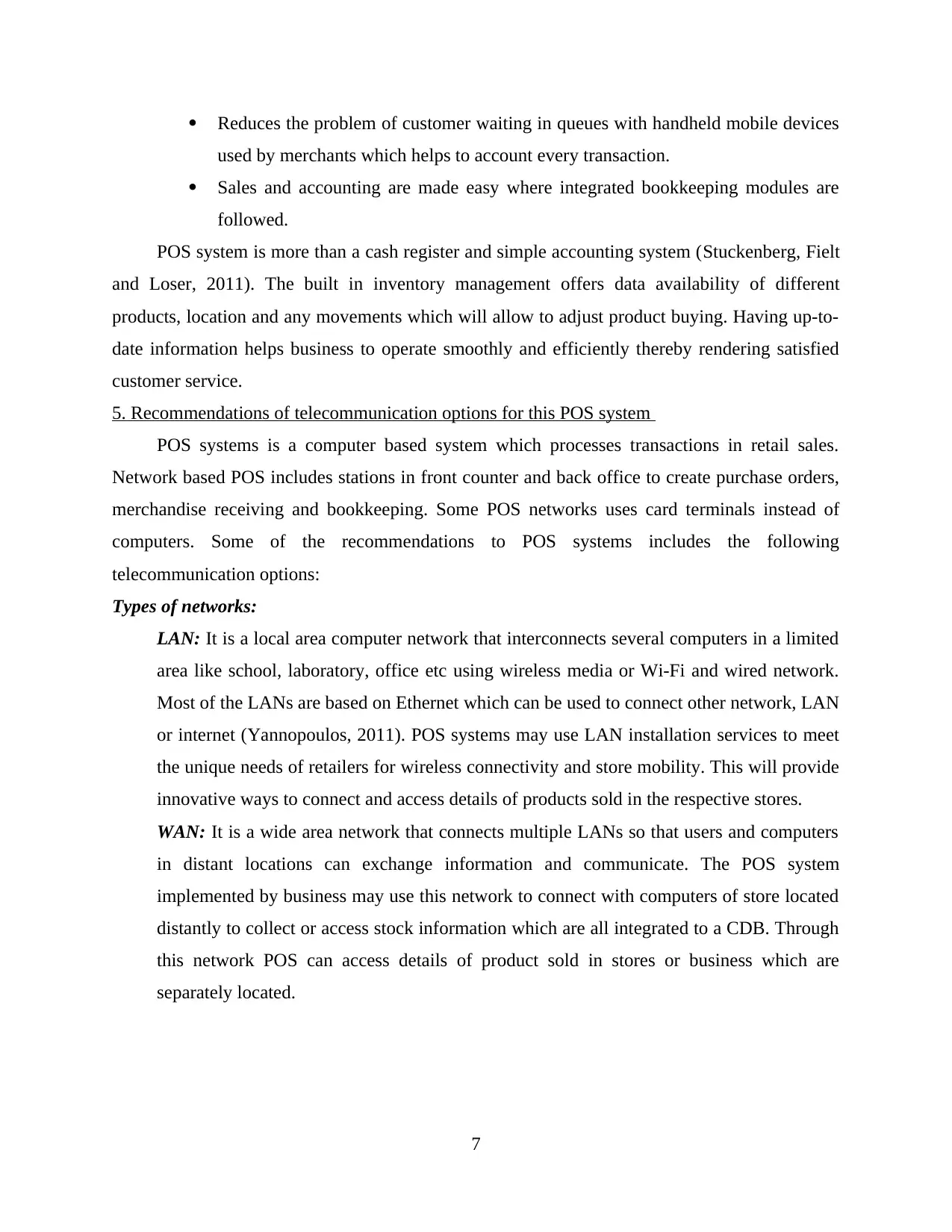
Reduces the problem of customer waiting in queues with handheld mobile devices
used by merchants which helps to account every transaction.
Sales and accounting are made easy where integrated bookkeeping modules are
followed.
POS system is more than a cash register and simple accounting system (Stuckenberg, Fielt
and Loser, 2011). The built in inventory management offers data availability of different
products, location and any movements which will allow to adjust product buying. Having up-to-
date information helps business to operate smoothly and efficiently thereby rendering satisfied
customer service.
5. Recommendations of telecommunication options for this POS system
POS systems is a computer based system which processes transactions in retail sales.
Network based POS includes stations in front counter and back office to create purchase orders,
merchandise receiving and bookkeeping. Some POS networks uses card terminals instead of
computers. Some of the recommendations to POS systems includes the following
telecommunication options:
Types of networks:
LAN: It is a local area computer network that interconnects several computers in a limited
area like school, laboratory, office etc using wireless media or Wi-Fi and wired network.
Most of the LANs are based on Ethernet which can be used to connect other network, LAN
or internet (Yannopoulos, 2011). POS systems may use LAN installation services to meet
the unique needs of retailers for wireless connectivity and store mobility. This will provide
innovative ways to connect and access details of products sold in the respective stores.
WAN: It is a wide area network that connects multiple LANs so that users and computers
in distant locations can exchange information and communicate. The POS system
implemented by business may use this network to connect with computers of store located
distantly to collect or access stock information which are all integrated to a CDB. Through
this network POS can access details of product sold in stores or business which are
separately located.
7
used by merchants which helps to account every transaction.
Sales and accounting are made easy where integrated bookkeeping modules are
followed.
POS system is more than a cash register and simple accounting system (Stuckenberg, Fielt
and Loser, 2011). The built in inventory management offers data availability of different
products, location and any movements which will allow to adjust product buying. Having up-to-
date information helps business to operate smoothly and efficiently thereby rendering satisfied
customer service.
5. Recommendations of telecommunication options for this POS system
POS systems is a computer based system which processes transactions in retail sales.
Network based POS includes stations in front counter and back office to create purchase orders,
merchandise receiving and bookkeeping. Some POS networks uses card terminals instead of
computers. Some of the recommendations to POS systems includes the following
telecommunication options:
Types of networks:
LAN: It is a local area computer network that interconnects several computers in a limited
area like school, laboratory, office etc using wireless media or Wi-Fi and wired network.
Most of the LANs are based on Ethernet which can be used to connect other network, LAN
or internet (Yannopoulos, 2011). POS systems may use LAN installation services to meet
the unique needs of retailers for wireless connectivity and store mobility. This will provide
innovative ways to connect and access details of products sold in the respective stores.
WAN: It is a wide area network that connects multiple LANs so that users and computers
in distant locations can exchange information and communicate. The POS system
implemented by business may use this network to connect with computers of store located
distantly to collect or access stock information which are all integrated to a CDB. Through
this network POS can access details of product sold in stores or business which are
separately located.
7
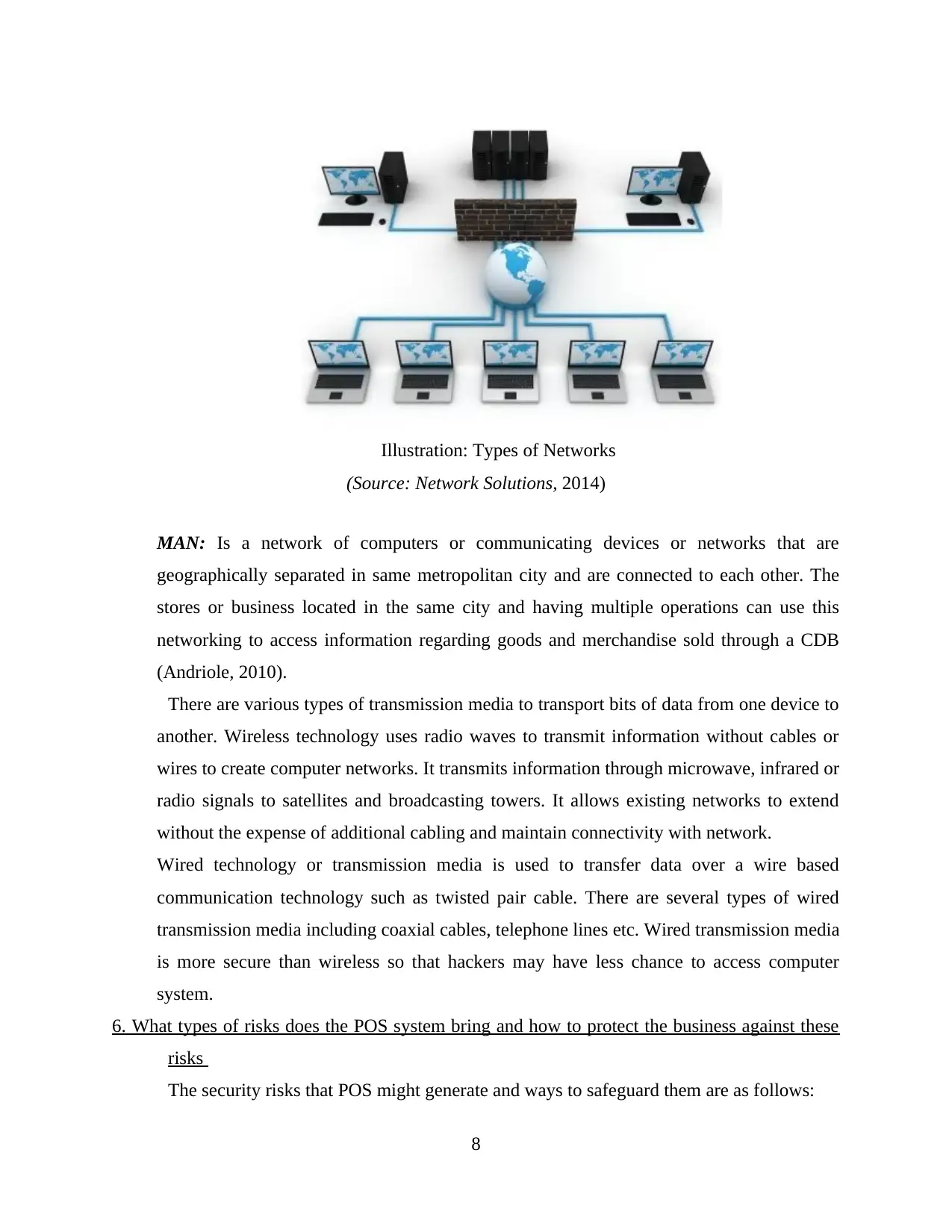
Illustration: Types of Networks
(Source: Network Solutions, 2014)
MAN: Is a network of computers or communicating devices or networks that are
geographically separated in same metropolitan city and are connected to each other. The
stores or business located in the same city and having multiple operations can use this
networking to access information regarding goods and merchandise sold through a CDB
(Andriole, 2010).
There are various types of transmission media to transport bits of data from one device to
another. Wireless technology uses radio waves to transmit information without cables or
wires to create computer networks. It transmits information through microwave, infrared or
radio signals to satellites and broadcasting towers. It allows existing networks to extend
without the expense of additional cabling and maintain connectivity with network.
Wired technology or transmission media is used to transfer data over a wire based
communication technology such as twisted pair cable. There are several types of wired
transmission media including coaxial cables, telephone lines etc. Wired transmission media
is more secure than wireless so that hackers may have less chance to access computer
system.
6. What types of risks does the POS system bring and how to protect the business against these
risks
The security risks that POS might generate and ways to safeguard them are as follows:
8
(Source: Network Solutions, 2014)
MAN: Is a network of computers or communicating devices or networks that are
geographically separated in same metropolitan city and are connected to each other. The
stores or business located in the same city and having multiple operations can use this
networking to access information regarding goods and merchandise sold through a CDB
(Andriole, 2010).
There are various types of transmission media to transport bits of data from one device to
another. Wireless technology uses radio waves to transmit information without cables or
wires to create computer networks. It transmits information through microwave, infrared or
radio signals to satellites and broadcasting towers. It allows existing networks to extend
without the expense of additional cabling and maintain connectivity with network.
Wired technology or transmission media is used to transfer data over a wire based
communication technology such as twisted pair cable. There are several types of wired
transmission media including coaxial cables, telephone lines etc. Wired transmission media
is more secure than wireless so that hackers may have less chance to access computer
system.
6. What types of risks does the POS system bring and how to protect the business against these
risks
The security risks that POS might generate and ways to safeguard them are as follows:
8
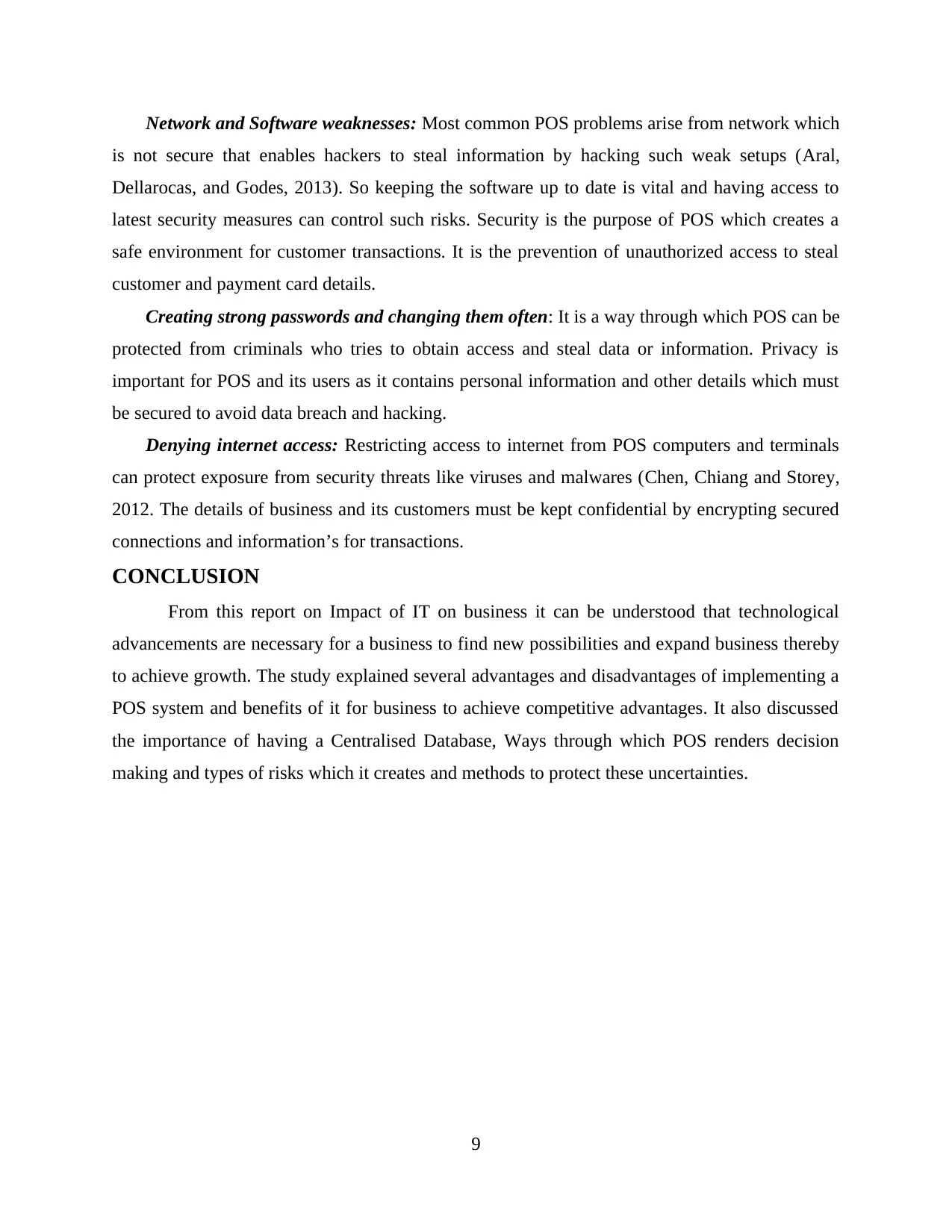
Network and Software weaknesses: Most common POS problems arise from network which
is not secure that enables hackers to steal information by hacking such weak setups (Aral,
Dellarocas, and Godes, 2013). So keeping the software up to date is vital and having access to
latest security measures can control such risks. Security is the purpose of POS which creates a
safe environment for customer transactions. It is the prevention of unauthorized access to steal
customer and payment card details.
Creating strong passwords and changing them often: It is a way through which POS can be
protected from criminals who tries to obtain access and steal data or information. Privacy is
important for POS and its users as it contains personal information and other details which must
be secured to avoid data breach and hacking.
Denying internet access: Restricting access to internet from POS computers and terminals
can protect exposure from security threats like viruses and malwares (Chen, Chiang and Storey,
2012. The details of business and its customers must be kept confidential by encrypting secured
connections and information’s for transactions.
CONCLUSION
From this report on Impact of IT on business it can be understood that technological
advancements are necessary for a business to find new possibilities and expand business thereby
to achieve growth. The study explained several advantages and disadvantages of implementing a
POS system and benefits of it for business to achieve competitive advantages. It also discussed
the importance of having a Centralised Database, Ways through which POS renders decision
making and types of risks which it creates and methods to protect these uncertainties.
9
is not secure that enables hackers to steal information by hacking such weak setups (Aral,
Dellarocas, and Godes, 2013). So keeping the software up to date is vital and having access to
latest security measures can control such risks. Security is the purpose of POS which creates a
safe environment for customer transactions. It is the prevention of unauthorized access to steal
customer and payment card details.
Creating strong passwords and changing them often: It is a way through which POS can be
protected from criminals who tries to obtain access and steal data or information. Privacy is
important for POS and its users as it contains personal information and other details which must
be secured to avoid data breach and hacking.
Denying internet access: Restricting access to internet from POS computers and terminals
can protect exposure from security threats like viruses and malwares (Chen, Chiang and Storey,
2012. The details of business and its customers must be kept confidential by encrypting secured
connections and information’s for transactions.
CONCLUSION
From this report on Impact of IT on business it can be understood that technological
advancements are necessary for a business to find new possibilities and expand business thereby
to achieve growth. The study explained several advantages and disadvantages of implementing a
POS system and benefits of it for business to achieve competitive advantages. It also discussed
the importance of having a Centralised Database, Ways through which POS renders decision
making and types of risks which it creates and methods to protect these uncertainties.
9
Secure Best Marks with AI Grader
Need help grading? Try our AI Grader for instant feedback on your assignments.
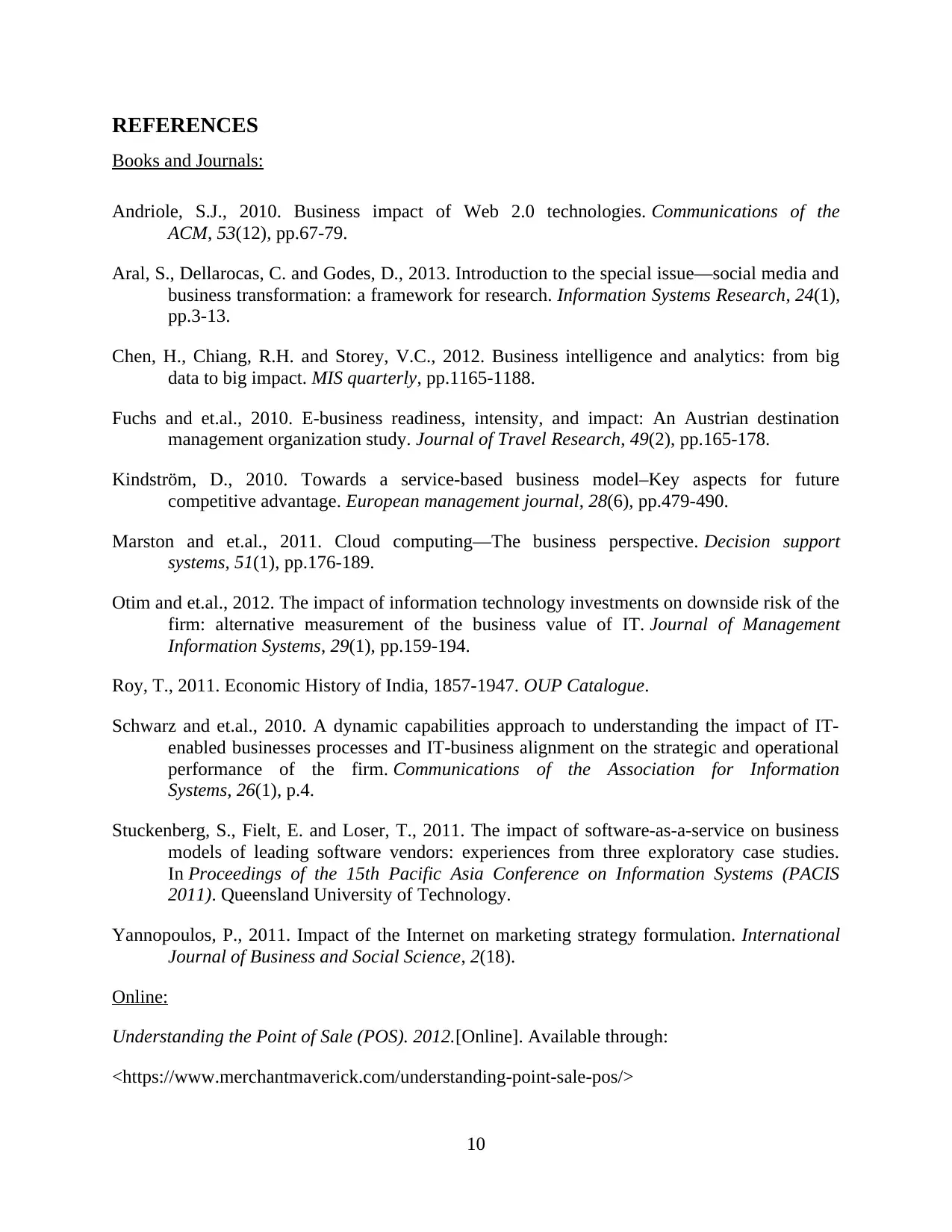
REFERENCES
Books and Journals:
Andriole, S.J., 2010. Business impact of Web 2.0 technologies. Communications of the
ACM, 53(12), pp.67-79.
Aral, S., Dellarocas, C. and Godes, D., 2013. Introduction to the special issue—social media and
business transformation: a framework for research. Information Systems Research, 24(1),
pp.3-13.
Chen, H., Chiang, R.H. and Storey, V.C., 2012. Business intelligence and analytics: from big
data to big impact. MIS quarterly, pp.1165-1188.
Fuchs and et.al., 2010. E-business readiness, intensity, and impact: An Austrian destination
management organization study. Journal of Travel Research, 49(2), pp.165-178.
Kindström, D., 2010. Towards a service-based business model–Key aspects for future
competitive advantage. European management journal, 28(6), pp.479-490.
Marston and et.al., 2011. Cloud computing—The business perspective. Decision support
systems, 51(1), pp.176-189.
Otim and et.al., 2012. The impact of information technology investments on downside risk of the
firm: alternative measurement of the business value of IT. Journal of Management
Information Systems, 29(1), pp.159-194.
Roy, T., 2011. Economic History of India, 1857-1947. OUP Catalogue.
Schwarz and et.al., 2010. A dynamic capabilities approach to understanding the impact of IT-
enabled businesses processes and IT-business alignment on the strategic and operational
performance of the firm. Communications of the Association for Information
Systems, 26(1), p.4.
Stuckenberg, S., Fielt, E. and Loser, T., 2011. The impact of software-as-a-service on business
models of leading software vendors: experiences from three exploratory case studies.
In Proceedings of the 15th Pacific Asia Conference on Information Systems (PACIS
2011). Queensland University of Technology.
Yannopoulos, P., 2011. Impact of the Internet on marketing strategy formulation. International
Journal of Business and Social Science, 2(18).
Online:
Understanding the Point of Sale (POS). 2012.[Online]. Available through:
<https://www.merchantmaverick.com/understanding-point-sale-pos/>
10
Books and Journals:
Andriole, S.J., 2010. Business impact of Web 2.0 technologies. Communications of the
ACM, 53(12), pp.67-79.
Aral, S., Dellarocas, C. and Godes, D., 2013. Introduction to the special issue—social media and
business transformation: a framework for research. Information Systems Research, 24(1),
pp.3-13.
Chen, H., Chiang, R.H. and Storey, V.C., 2012. Business intelligence and analytics: from big
data to big impact. MIS quarterly, pp.1165-1188.
Fuchs and et.al., 2010. E-business readiness, intensity, and impact: An Austrian destination
management organization study. Journal of Travel Research, 49(2), pp.165-178.
Kindström, D., 2010. Towards a service-based business model–Key aspects for future
competitive advantage. European management journal, 28(6), pp.479-490.
Marston and et.al., 2011. Cloud computing—The business perspective. Decision support
systems, 51(1), pp.176-189.
Otim and et.al., 2012. The impact of information technology investments on downside risk of the
firm: alternative measurement of the business value of IT. Journal of Management
Information Systems, 29(1), pp.159-194.
Roy, T., 2011. Economic History of India, 1857-1947. OUP Catalogue.
Schwarz and et.al., 2010. A dynamic capabilities approach to understanding the impact of IT-
enabled businesses processes and IT-business alignment on the strategic and operational
performance of the firm. Communications of the Association for Information
Systems, 26(1), p.4.
Stuckenberg, S., Fielt, E. and Loser, T., 2011. The impact of software-as-a-service on business
models of leading software vendors: experiences from three exploratory case studies.
In Proceedings of the 15th Pacific Asia Conference on Information Systems (PACIS
2011). Queensland University of Technology.
Yannopoulos, P., 2011. Impact of the Internet on marketing strategy formulation. International
Journal of Business and Social Science, 2(18).
Online:
Understanding the Point of Sale (POS). 2012.[Online]. Available through:
<https://www.merchantmaverick.com/understanding-point-sale-pos/>
10

Network Solutions.2014. [Online]. Available through:
<http://www.kuzeyyazilim.com/network-cozumlerimiz/>
11
<http://www.kuzeyyazilim.com/network-cozumlerimiz/>
11
1 out of 12
Related Documents
Your All-in-One AI-Powered Toolkit for Academic Success.
+13062052269
info@desklib.com
Available 24*7 on WhatsApp / Email
![[object Object]](/_next/static/media/star-bottom.7253800d.svg)
Unlock your academic potential
© 2024 | Zucol Services PVT LTD | All rights reserved.





